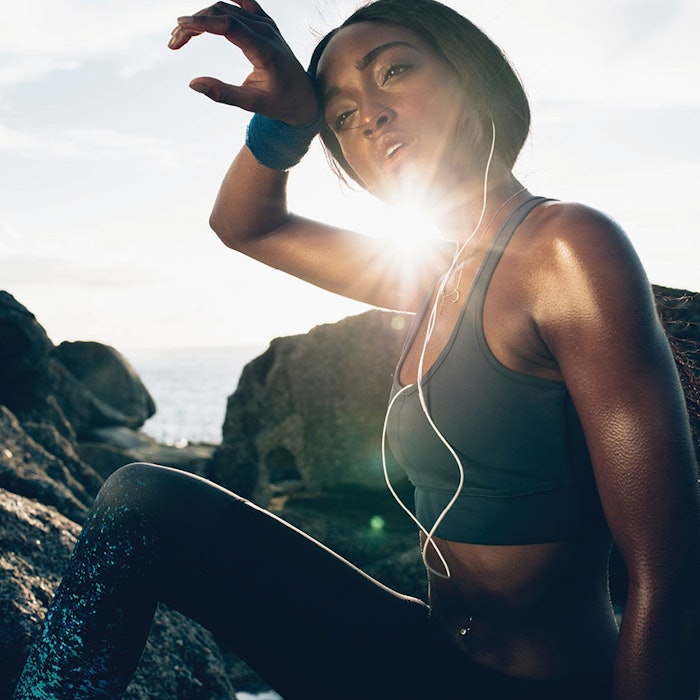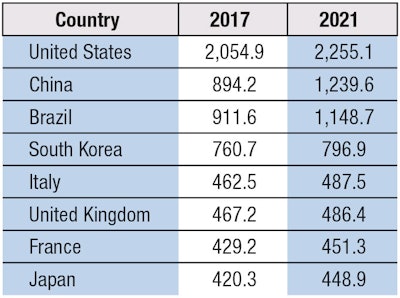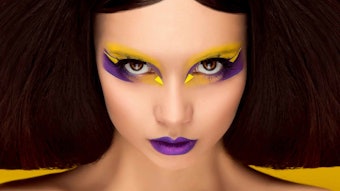
*Adapted with permission from Global Cosmetic Industry; see GCImagazine.com
The global sun care market was valued at $9.8 billion in 2017, according Euromonitor (see Table 1 and Table 2). Beyond consumer awareness of the need for sun protection, drivers include unique formats, ingredients and emerging test methods. Here, three approaches brands are taking to shake up this category are described.
1. Make It Fun and Easy
Sundots, a brand of bite-sized gummies to protect against sun damage, recently launched its funding campaign on crowd funding site Indiegogo. The brand was co-developed by Emilia Javorsky, M.D., a physician and research scientist, and designed to strengthen skin’s UV resistance from the inside out.
Sundots leverages Polypodium leucotomos fern extract as its key active to help skin resist UV damage. A 2015 dermatology study1 on the extract’s safety and efficacy concluded, “Polypodium leucotomos extract (240 mg) taken twice daily for 60 days was a safe and effective means for reducing the damaging effects of ultraviolet radiation.” Sundots also cites a 2017 study that found 76% fewer new sunburned cells in patients who took Polypodium.2
Other brands have leveraged the ingredient for supplement-format sun care products, including Heliocare’s Sun Protection Pills, which reportedly improve the body’s tolerance to UV rays to prevent sun-damaged skin. The brand is clear to warn, however, “Although Heliocare tablets aid in preventing sun damage, they do not replace sunscreen. We recommended applying a topical sunscreen with SPF for maximum results.”
Hum Nutrition also includes the ingredient in its Turn Back Time Anti-Aging Supplement, which claims to protect the skin against UV damage, stress and pollution.
Sundots proposes its supplements can fill in the gaps where consumers fail to apply or reapply appropriate amounts of sunscreen. It also offers a solution for consumers concerned about finding natural products. In addition, by offering a chewable, pleasant-tasting supplement, Sundots believes it can encourage consumers to incorporate UV protection into their daily lives—not just at the beach.
While the brand is in startup mode, its funding drive is already a hit. With about one month of funding left to go (as of press time), Sundots surpassed its $20,000 goal, achieving $47,746.
2. Make It Inclusive
The rise of inclusive beauty is often focused on makeup and hair care, but there are significant implications in the sun care sector as well. As consumers of every skin tone increasingly demand effective beauty products, a new wave of innovation has hit the market.
For instance, Heather Woolery-Lloyd, M.D., a U.S. board-certified dermatologist, created Specific Beauty to help people with “melanin-rich complexions” achieve flawless, even-toned skin. The brand’s range includes a water-resistant SPF 30 Active Radiance Day Face Moisturizer; an oil-free, lightweight product designed to absorb quickly. The product is intended to defend against UVB and UVA to prevent discoloration and dark spots. The formula includes niacinamide, linoleic acid, and licorice and emblica extracts, as well as light-refracting gold illuminizers to “deliver radiance,” according to the brand.
Another brand, UnSun, was made “specifically for people of color representing the beige to dark chocolate tones of the spectrum,” founder Katonya Breaux has said. “The desire to protect our skin from the sun should not mean having to wear foundation in order to cover the white and gray film that’s present after application. UnSun was specially formulated with a mineral tint to address this concern.”
The brand’s hero product, the UnSun SPF 30 tinted mineral sunscreen contains shea butter, vitamin E, coconut oil and fruit extracts, and is “tinted to blend in with multiple skin tones that range from fair to olive to the darkest of chocolate,” according to the company. UnSun has since expanded to include a Hand Cream SPF 15 and a collection of organic SPF 15 Lip Tints in shades that range from Slay and Nekkid, to Rose Gold.
MyChelle Dermaceuticals also introduced a mineral-based sunscreen that offers UVA/UVB broad-spectrum protection, “with just enough color to enhance any skin tone.” The tinted Sun Shield Stick SPF 50 comprises avocado, jojoba and vitamin E to boost moisture.
3. Deliver New Performance
Improving existing formats and creating new ones is another strategy for bringing new excitement to sun care. For example, after her own experience with skin cancer, Gillian Robson looked for a product that offered self-tanning with sun protection but could not find one. So, working with co-founder Katy Foxcroft, sun protection expert Jack Ferguson, Ph.D., and experienced formulator Jo Warren, Foxcroft developed her own. The result was Tancream, a blend of organic sunscreens, gradual self-tanners and instant bronzers that offers SPF 50 protection, according to the brand. The premium luxury lotion, which was featured at the CEW UK product demo event, has anti-aging properties, no odor and does not streak.
Finally, SkinCeuticals launched Discoloration Defense, a corrective serum that reportedly counteracts the production of excess melanin caused by UV exposure, prescription drugs and some professional treatments.
According to the company, the product is formulated with 3% tranexamic acid to minimize the appearance of discoloration and brown patches; 5% niacinamide to reduce the appearance of discoloration; 5% 4-(2-hydroxyethyl)-1-piperazineethanesulfonic acid to boost cell turnover; and 1% kojic acid to enhance skin brightness.
In a 12-week clinical study, these key ingredients generated an average reduction in the appearance of brown patches by 60%, discoloration by 59% and post-acne marks by 81%. It also improved overall skin tone by an average 59%.
References
- MS Nestor, B Berman and N Swenson, Safety and efficacy of oral Polypodium leucotomos extract in healthy adult subjects, J Clin Aesthet Dermatol 8(2) 19–23 (Feb 2015)
- I Kohli, et al, The impact of oral Polypodium leucotomos extract on UVB response: A human clinical study, J Am Acad Dermatol 77(1) 33–41 (2017)













